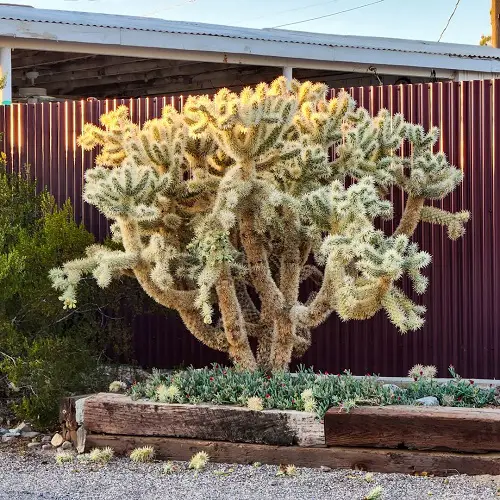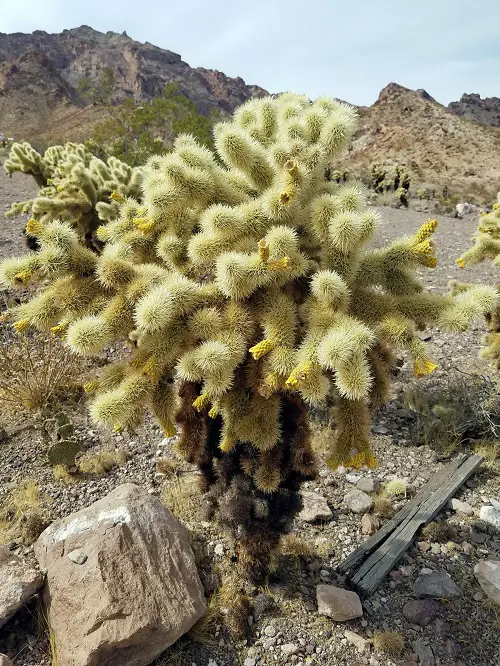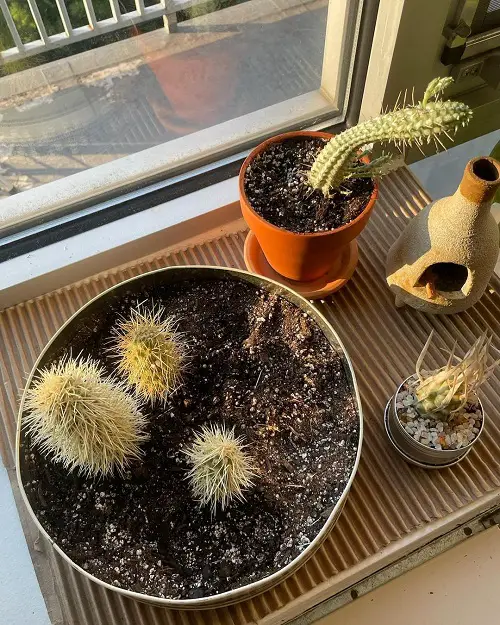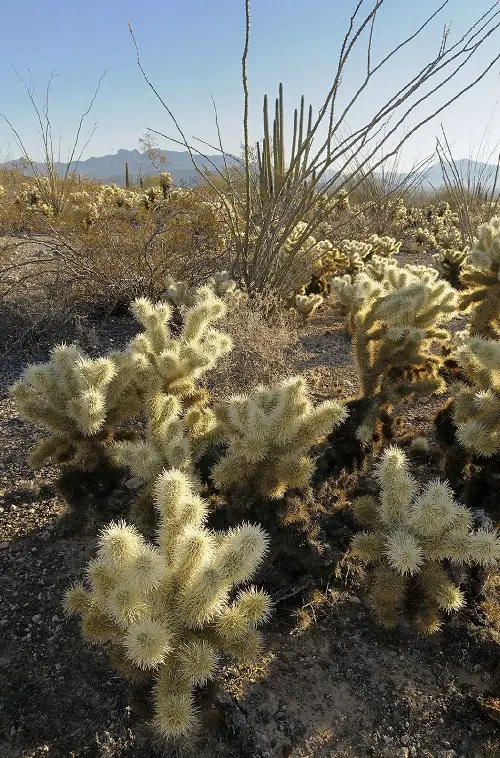Discover the prickly and fascinating world of the Jumping Cholla Cactus with our guide! We have all the information and details!

Looking for a plant with a name that’s as prickly as its appearance? Look no further than the Jumping Cholla Cactus! This desert-dwelling plant is a master of survival in the harsh environment of the American Southwest and is known for its unique defense mechanism. Keep on reading to find out all the details.
Botanical Name: Cylindropuntia fulgida
USDA Zones: 8 to 12
Common Names: Hanging Chain Cholla, Chain Fruit Cholla, and the Jumping Cactus
Here is our Boobie Cactus Care and Growing Guide
Jumping Cholla Cactus Plant Information

The Jumping Cholla Cactus, also known as the Teddy Bear Cholla, is a type of cactus native to the deserts of the southwestern United States and Mexico.
One of the most distinctive features of the Jumping Cholla Cactus is its spines. The cactus is covered in clusters of long, sharp spines that can easily detach and cling to anything that comes too close, earning it the nickname of the “jumping” cactus. These spines are not only sharp but also barbed, making them difficult to remove once they’ve embedded in skin or clothing.
Despite its prickly appearance and reputation, the Jumping Cholla Cactus is actually an important source of food and shelter for many desert animals. Its clusters of spines provide shade and protection from predators, while its fruit and seeds are a valuable food source for birds, rodents, and insects.
The cactus is also a popular ornamental plant in arid and desert landscapes, valued for its unique appearance and low-maintenance requirements.
Here is the best Fern Leaf Cactus Care and Growing Guide
Jumping Cholla Cactus Facts

- The Jumping Cholla Cactus gets its name from its tendency to detach easily and “jump” onto anything that brushes against it, including animals and humans!
- The cactus is native to the southwestern United States and northern Mexico and is well-suited to hot, arid environments.
- The Jumping Cholla Cactus can grow up to 7-10 feet tall and 4-6 feet wide, with long, hanging chains of spiny stems that give it a distinctive appearance.
- The cactus blooms in the spring, producing beautiful pink, purple, or red flowers that attract bees, butterflies, and other pollinators.
- Despite its spiny exterior, the Jumping Cholla Cactus is a valuable source of food and shelter for desert wildlife, including birds, rodents, and insects.
- The cactus is relatively low-maintenance and doesn’t require much water or fertilizer to thrive.
- The Jumping Cholla Cactus is one of the most commonly encountered cacti in the Sonoran Desert. Its distinctive appearance and behavior make it a popular subject for photographers and artists alike.
Here’s all you need to know about growing dog tail cactus
Jumping Cholla Growth Requirements

Sunlight
To thrive, the Jumping Cholla Cactus requires plenty of sunlight. It is a full-sun plant, which means it needs at least 6-7 hours of direct sunlight every day.
Without adequate sunlight, the cactus may become weak and prone to disease. It is, therefore, best to plant it in a location that receives plenty of sunlight throughout the day.
Soil
When it comes to soil, the Jumping Cholla Cactus is not too picky and can grow in a variety of soil types, including sandy, gravelly, or rocky soils.
The most important thing is that the soil is well-draining, as the cactus is sensitive to root rot. The best-growing medium is a mixture of equal parts potting soil, coarse sand, and pumice.
Water
Jumping Cholla Cactus is a desert plant adapted to survive long periods of drought, but it still requires some water to thrive. In general, the cactus should be watered deeply but infrequently, allowing the soil to dry out completely between waterings.
Temperature
The Jumping Cholla Cactus is well-suited to hot, dry climates. It can tolerate extreme heat and cold as long as it is not exposed to prolonged periods of freezing temperatures.
In general, the cactus prefers temperatures between 21°C and 48°C (70°F and 120°F) during the day and between 10°C and 21°C (50°F and 70°F) at night.
If the temperature drops below freezing for extended periods, the cactus may suffer damage or die off.
Jumping Cholla Cactus Care
Fertilizer
The cactus doesn’t require much fertilizer to thrive, as it is adapted to grow in nutrient-poor soils. However, if you want to give it a boost, fertilize it once a year in the spring using a low-nitrogen fertilizer.
Be sure to follow the instructions on the fertilizer package carefully, as over-fertilizing can damage the cactus.
Check out our article on the best fertilizer for cacti here
Pests and Diseases
The Jumping Cholla cactus is relatively resistant to insects and diseases. However, it may occasionally be attacked by spider mites, scale insects, or mealybugs.
If you notice any signs of infestation, such as yellowing or distorted growth, you can try to remove the pests by hand or with a mild soap and water solution.
To prevent root rot, be sure to plant your cactus in well-draining soil and avoid over-watering it.
Additionally, the cactus may occasionally develop fungal infections, such as stem rot or cankers. If you notice any signs of fungal infection, such as black or brown spots on the stems, you can try to remove the affected areas and treat the cactus with a fungicide.



